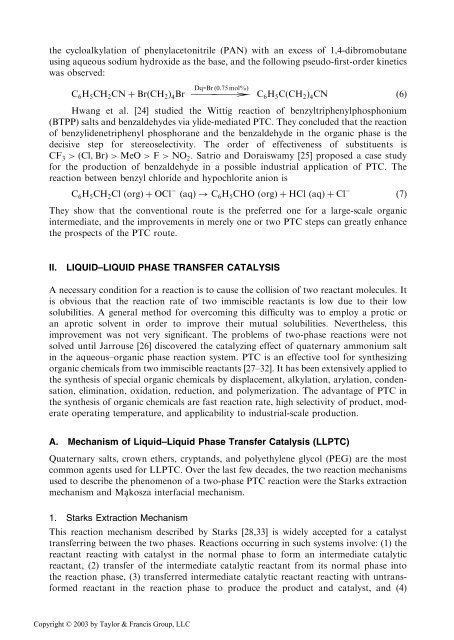11. Interfacial Mechanism and Kinetics of Phase-Transfer Catalysis
11. Interfacial Mechanism and Kinetics of Phase-Transfer Catalysis
11. Interfacial Mechanism and Kinetics of Phase-Transfer Catalysis
Create successful ePaper yourself
Turn your PDF publications into a flip-book with our unique Google optimized e-Paper software.
the cycloalkylation <strong>of</strong> phenylacetonitrile (PAN) with an excess <strong>of</strong> 1,4-dibromobutaneusing aqueous sodium hydroxide as the base, <strong>and</strong> the following pseudo-first-order kineticswas observed:C 6 H 5 CH 2 CN þ BrðCH 2 Þ 4 Br Dq-Br !ð0:75 mol%Þ C 6 H 5 CðCH 2 Þ 4 CN ð6ÞHwang et al. [24] studied the Wittig reaction <strong>of</strong> benzyltriphenylphosphonium(BTPP) salts <strong>and</strong> benzaldehydes via ylide-mediated PTC. They concluded that the reaction<strong>of</strong> benzylidenetriphenyl phosphorane <strong>and</strong> the benzaldehyde in the organic phase is thedecisive step for stereoselectivity. The order <strong>of</strong> effectiveness <strong>of</strong> substituents isCF 3 > ðCl; BrÞ > MeO > F > NO 2 . Satrio <strong>and</strong> Doraiswamy [25] proposed a case studyfor the production <strong>of</strong> benzaldehyde in a possible industrial application <strong>of</strong> PTC. Thereaction between benzyl chloride <strong>and</strong> hypochlorite anion isC 6 H 5 CH 2 Cl ðorgÞþOCl ðaqÞ !C 6 H 5 CHO ðorgÞþHCl ðaqÞþCl ð7ÞThey show that the conventional route is the preferred one for a large-scale organicintermediate, <strong>and</strong> the improvements in merely one or two PTC steps can greatly enhancethe prospects <strong>of</strong> the PTC route.II.LIQUID–LIQUID PHASE TRANSFER CATALYSISA necessary condition for a reaction is to cause the collision <strong>of</strong> two reactant molecules. Itis obvious that the reaction rate <strong>of</strong> two immiscible reactants is low due to their lowsolubilities. A general method for overcoming this difficulty was to employ a protic oran aprotic solvent in order to improve their mutual solubilities. Nevertheless, thisimprovement was not very significant. The problems <strong>of</strong> two-phase reactions were notsolved until Jarrouse [26] discovered the catalyzing effect <strong>of</strong> quaternary ammonium saltin the aqueous–organic phase reaction system. PTC is an effective tool for synthesizingorganic chemicals from two immiscible reactants [27–32]. It has been extensively applied tothe synthesis <strong>of</strong> special organic chemicals by displacement, alkylation, arylation, condensation,elimination, oxidation, reduction, <strong>and</strong> polymerization. The advantage <strong>of</strong> PTC inthe synthesis <strong>of</strong> organic chemicals are fast reaction rate, high selectivity <strong>of</strong> product, moderateoperating temperature, <strong>and</strong> applicability to industrial-scale production.A. <strong>Mechanism</strong> <strong>of</strong> Liquid–Liquid <strong>Phase</strong> <strong>Transfer</strong> <strong>Catalysis</strong> (LLPTC)Quaternary salts, crown ethers, crypt<strong>and</strong>s, <strong>and</strong> polyethylene glycol (PEG) are the mostcommon agents used for LLPTC. Over the last few decades, the two reaction mechanismsused to describe the phenomenon <strong>of</strong> a two-phase PTC reaction were the Starks extractionmechanism <strong>and</strong> Mąkosza interfacial mechanism.1. Starks Extraction <strong>Mechanism</strong>This reaction mechanism described by Starks [28,33] is widely accepted for a catalysttransferring between the two phases. Reactions occurring in such systems involve: (1) thereactant reacting with catalyst in the normal phase to form an intermediate catalyticreactant, (2) transfer <strong>of</strong> the intermediate catalytic reactant from its normal phase intothe reaction phase, (3) transferred intermediate catalytic reactant reacting with untransformedreactant in the reaction phase to produce the product <strong>and</strong> catalyst, <strong>and</strong> (4)Copyright © 2003 by Taylor & Francis Group, LLC
















